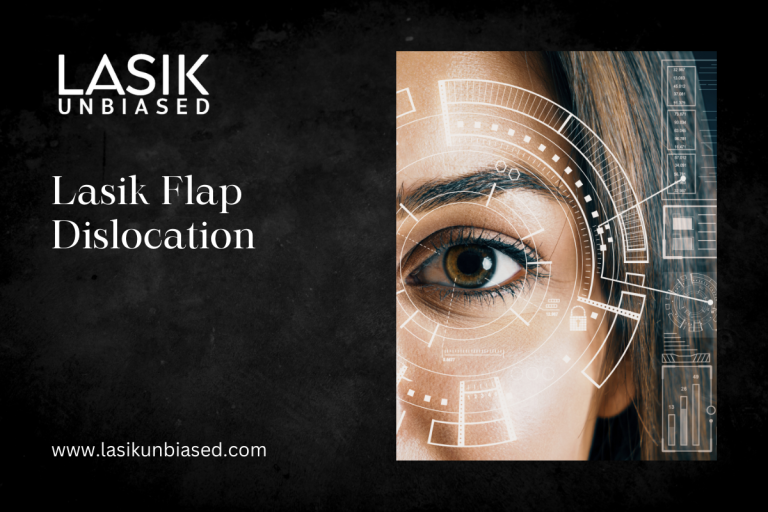LASIK (Laser-Assisted in Situ Keratomileusis) has revolutionized the world of vision correction, offering millions of people the chance to break free from glasses and contact lenses. This highly effective procedure reshapes the cornea to improve focus and correct common refractive errors such as myopia (nearsightedness), hyperopia (farsightedness), and astigmatism. However, like any surgery, LASIK comes with its potential risks. One such risk is flap dislocation, which requires attention but can often be addressed successfully when caught early.
What is LASIK Flap Dislocation?
During LASIK surgery, a thin flap of corneal tissue is created and temporarily lifted to allow a laser to reshape the underlying cornea. After the procedure, the flap is then placed back in position, where it naturally adheres to the cornea. Flap dislocation occurs when this flap becomes displaced or moves out of position after the surgery. Though it is a rare complication, flap dislocation can be concerning for patients, and prompt treatment is needed to prevent long-term vision issues.
Causes of LASIK Flap Dislocation
Flap dislocation can occur due to a variety of reasons. One of the most common causes is trauma or injury to the eye during the initial healing period after the surgery. A simple bump or rub to the eye, especially in the first few days or weeks after LASIK, can cause the flap to shift. For this reason, patients are typically advised to avoid vigorous activities, including sports, and to take extra care in protecting the eyes during the healing process.
In rare cases, flap dislocation may occur due to underlying issues with the flap’s creation. If the flap is too thin or irregularly shaped, it might be more prone to displacement. This is why preoperative assessments and advanced techniques are critical for ensuring the best possible flap formation.
Symptoms of LASIK Flap Dislocation
Flap dislocation may present with noticeable symptoms. If you experience any of the following after LASIK surgery, it is essential to consult your ophthalmologist immediately:
- A sudden decrease in vision clarity
- The blurry or distorted vision that was not present before
- A feeling of something foreign in the eye
- Pain or discomfort, especially in the days following the surgery
- Light sensitivity or halos around lights
These symptoms are not necessarily unique to flap dislocation and can occur for other reasons post-surgery. However, seeking professional advice is always a good idea if you notice any sudden change in vision or discomfort.
How is Flap Dislocation Diagnosed?
A comprehensive eye examination by an experienced ophthalmologist is required to diagnose flap dislocation. This typically involves the use of a slit-lamp microscope, which allows the doctor to examine the cornea and flap closely. In some cases, additional imaging may be used to assess the flap’s position in detail.
Once the diagnosis is confirmed, the ophthalmologist will determine the severity of the dislocation and recommend the most appropriate treatment plan.
Treatment for LASIK Flap Dislocation
The good news is that flap dislocation is treatable and, in most cases, can be addressed effectively with a simple procedure. If the flap has shifted slightly, the doctor may be able to reposition it with minimal intervention. In more severe cases, the flap may need to be lifted, cleaned, and repositioned to ensure it adheres correctly.
Sometimes, a small amount of medication or a bandage contact lens may be used to promote healing. After the flap is repositioned, patients are typically instructed to avoid rubbing their eyes and to follow a strict postoperative care regimen to allow the cornea to heal correctly.
The surgeon may recommend further surgical intervention to correct the issue in rare cases where the flap has been severely damaged or cannot be repositioned successfully.
Recovery and Aftercare
The recovery process after flap dislocation treatment is generally quick and straightforward. Following repositioning or corrective surgery, patients will be monitored to ensure the flap heals correctly. It is crucial to follow all postoperative instructions to minimize the risk of further complications.
Patients will typically be prescribed antibiotics, and anti-inflammatory eye drops to reduce the risk of infection and inflammation. Additionally, bandage contact lenses may be used for comfort and to promote proper healing during recovery. Wearing protective eyewear while sleeping is also recommended to prevent accidental rubbing of the eyes, which could lead to further dislocation.
While full recovery usually takes a few weeks, many patients experience significant improvement in vision within a short time. Attending all follow-up appointments is essential to ensuring that the healing process is progressing as expected.
Preventing Flap Dislocation After LASIK
Prevention is always the best approach when it comes to complications after LASIK. The first and most crucial step is to follow the post-surgical care instructions provided by your surgeon. These instructions typically include avoiding activities that might lead to trauma, such as contact sports or high-impact exercises, during the initial healing period.
Protecting the eyes from dust, wind, or bright sunlight can help avoid irritation and potential injury. Wearing protective eyewear during sleep and being mindful of accidental eye rubbing are also critical steps in preventing flap dislocation.
Lastly, regular check-ups with your ophthalmologist will ensure that the healing process is on track and any potential issues are addressed promptly.
The Outlook for Patients with Flap Dislocation
While flap dislocation is a rare complication, it is essential to approach the issue with a positive mindset. With prompt intervention, most patients experience full recovery and restoration of their vision. Early detection, timely treatment, and diligent aftercare are key to a successful outcome.
The overall success rate of LASIK surgery remains exceptionally high, and even in cases of flap dislocation, the prognosis is generally excellent when appropriate treatment is provided. Advances in LASIK technology and surgical techniques continue to improve outcomes and reduce the risk of complications, including flap dislocation.
LASIK surgery offers life-changing benefits to millions seeking improved vision and reduced dependence on corrective lenses. While flap dislocation is a rare complication, it is essential to be aware of the symptoms and seek professional care if necessary. Proper management allows flap dislocation to be corrected effectively, and patients can return to enjoying their improved vision.
By adhering to recommended post-surgical guidelines and attending regular follow-up appointments, patients can reduce the risk of flap dislocation and ensure the best possible results from their LASIK procedure. As with any medical procedure, communication with your surgeon and taking proactive steps in your recovery will go a long way in securing long-term success and satisfaction.


